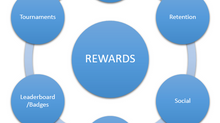Gamification Design
- Vishwajeet Kale
- Dec 2, 2015
- 3 min read
I’ve been researching on this topic for a couple of years now and it really interests me as to how we as Game Designers can integrate game design elements into processes. Processes as simple as in our day to day tasks. I’ve been following several gamification blogs, studying procedures and frameworks where gamification is integrated on a corporate level, educational level and personal level. My inspiration towards learning and studying more about gamification design is Andrzej Marczewski, who is a pioneer in the field of gamification design
So what exactly is Gamification Design?
Gamification design is the application of merging game design elements in a process to make it more fun and engaging. There's a lot of buzz around the word gamification, and there's recently been a lot of controversy over whether or not it actually works. This controversy arises because not all gamification design frameworks are applicable to processes. Certain frameworks may or may not even work, some framework may need to undergo several iteration in order to meet business goals. The main focus elements of any gamification framework are engagement and motivation. Firstly, tackling what engagement is, you want to keep people engaged, few such ways are:
Make them think: People are more focused when they are trying to solve a problem.
Present: Do not throw every little information in the face of the user, let them take the effort of discovering pieces of information for themselves.
Curiosity: Give people something to look for, an objective.
Collaborative Environment: Create a collaborative environment where people can collaborate and solve the problem together.
Incentives: Reward people for the effort they put into solving the problem. Rewards should be used to build skill and motivation in order to be engaged in the activity of problem solving. A rewards system in gamification design, if crafted well, it facilitates to increase in motivation and leads people to being more productive and motivated.
Story drives engagement: People are constantly looking for something to relate to, we are used to learning through stories.
Gamification design comes with its cons and pros, it can either to amplify the ROI and successfully bring up a company or it can really demotivate the employees of the company and kill the process. A lack of motivation is at the root of the problem of slapped-on gamification that we see all over the place.
In my past industry experience, I have had the opportunity to work on a gamification framework which catered to a sales training program called The Training Game for a company called The Sales Huddle Group, NYC. This framework involved sales trainee who were educated about concepts of sales and procedures through a gamified fun experience versus tedious book material. This framework also involved a rewards systems and leaderboard for the sales people of the company who were rewarded with incentives based on their performance and ranking on the leaderboard.
After having done some background check on the company’s business goals, I worked around a framework which best suited the company’s employees and task force. Below is the framework I implemented for the company:

The sales people were mainly motivated because of the incentives. They were encouraged to be more productive and efficient because it did not only give them recognition in the organization, but also heavy on incentives. Now this model may not work in every company as every business has different goals.
To conclude, gamification design is a very intriguing concept of merging play with a process and it excites me as to how game design elements can be incorporated into process in order to make it more fun and engaging.
References
Atlas, R. (2015). Gamification, Rewards & Learning. Gamasutra
Marcsewzki, A. (2014) Marcsewzki’s Gamification Framework. Gamified UK












Comments